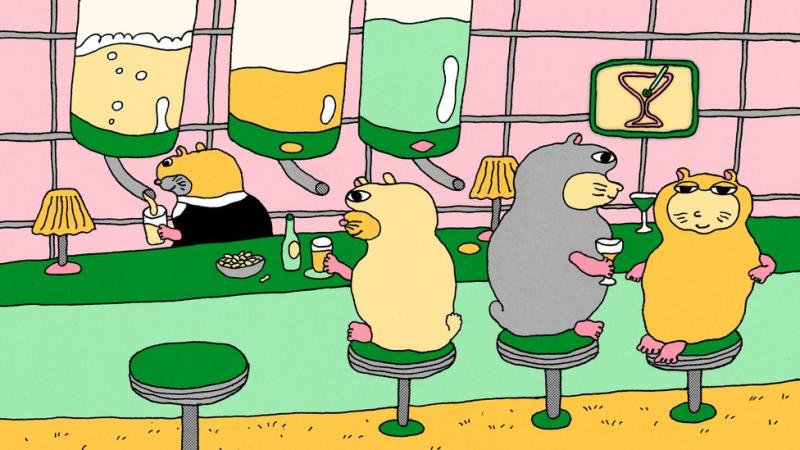You Have No Idea How Hard It Is to Get a Hamster Drunk
Category: Health, Science & Technology
Via: hallux • 3 years ago • 5 commentsBy: Sarah Zhang - The Atlantic


The heaviest drinkers in the animal kingdom are punier than you might expect. Elephants, for example, are massive, but they are relative lightweights—they lack a gene for alcohol metabolism . Humans actually rank pretty highly , thanks to our ancestors’ propensity for picking fermented fruit off the ground. But to find the real champs, you have to think smaller.
Think hoarder.
Think hamster.
“You just put a bottle of unsweetened Everclear on the cage and they love it,” says Gwen Lupfer, a psychologist at the University of Alaska Anchorage who has studied alcohol consumption in hamsters. They regularly down 18 grams per kilogram of body weight a day, the alcoholic equivalent of a human drinking a liter and a half of 190-proof Everclear . In the wild, hamsters hoard ryegrass seeds and fruit in their burrows, and they eat this fermenting store as it becomes more and more alcoholic over the winter. In the lab, well, they’re pretty happy with Everclear. Given the choice between water and alcohol, they go for the booze.
Humans have known about hamsters’ affinity for alcohol since at least the 1950s, when scientists in Texas found that hamsters could outdrink the common lab rat . Rats can be made to drink alcohol—either by selectively breeding genetic lines or by feeding them a mix of sugar and ethanol until they develop a taste for the latter. (Ethanol is the specific type of alcohol found in alcoholic drinks.) But with hamsters, “you could take a hamster right from the pet store and give it grain alcohol,” says Danielle Gulick, an addiction researcher at the University of Florida. “It would happily drink.”
And they can drink a lot before getting drunk. When Lupfer was studying dwarf hamsters , she and her students rated the animals’ drunkenness on a literal wobbling scale. They scored the hamsters from zero, for “no visible wobbling,” to four, for “falls onto side and does not right self.” (They had previously, unsuccessfully, tried to track the hamsters’ walking by dipping their paws in watercolor—they couldn’t tell the drunk and sober hamsters’ paw prints apart.) The hamsters never averaged above 0.5 on the wobbling scale—even at the highest oral doses. But when Lupfer and her team instead injected the ethanol directly into the hamsters’ abdomens, the animals didn’t do so well. They started wobbling and falling over at much, much lower doses.
Consumed orally, Lupfer explains, alcohol goes straight from the gut to the liver, which starts breaking down the mind-altering toxin that is ethanol. Hamster livers are “so efficient” at processing ethanol that very little ends up in their blood, says Tom Lawton, a critical-care doctor in Bradford, England. But when the hamsters got injected with ethanol, the substance could bypass the liver and go into their bloodstream and then their brain—hence much wobbling and falling over. Hamsters’ alcohol tolerance is likely an adaptation to their hoarding lifestyle. (Other animal hoarders might have evolved a similar tolerance, but they haven’t been as easy to study in a lab.) They would have a tough time getting through the winter, Lupfer told me, if they “didn’t like their own food that they’d hoarded or if they got sick from the alcohol in it.”
Hamsters don’t just tolerate alcohol, though; they prefer it to water—and that might be because they’re drinking for the calories. (Alcohol has seven calories per gram, almost as many as does fat, which clocks in at nine.) Gulick has found that giving hamsters sucrose water can suppress their boozing, but calorie-free saccharin water cannot. And in the ’90s, scientists investigating whether hamsters could be a good model for alcoholism studies decided to test ethanol against carefully calorie-matched offerings of tomato juice, peach juice, mango juice, sugar water, and a chocolate Ensure Plus nutrition shake. The hamsters indeed started drinking less alcohol when given sweet, calorie-rich alternatives. Chocolate Ensure Plus worked the best, which the researchers chalked up to a preference for its taste.
Lawton, who recently tweeted about hamsters and alcohol in a delightful thread , told me that he bred hamsters in his youth in Yorkshire. He did not learn until medical school that very serious scientists had studied hamsters’ alcoholic preferences. But as a teenager, he made a related discovery of his own. When his house got so cold that the hamsters would start hibernating, a spot of brandy would perk them right back up. Cheers.
Tags
Who is online
421 visitors

My father was a hamster, my brother was a hamster and I used to be a hamster ... alas no matter how hard I try Eliquis will not ferment.
The same must not be true for gerbils. I know this from personal experience, since I was once filled my gerbils’ water bottle with St. Pauli Girl decades ago. Man, did they get hammered. They drank that stuff up like nobody’s business, then fell over sideways. I never did that again, but I have to admit that it was kind of funny to watch at the time.
True story: when I bought them, my girlfriend and I decided to name them by randomly opening a dictionary and blindly putting a finger on a word. She went first and the word was “why”. We thought, well that was a dumb idea, but I went ahead and took my turn. My word was “because”. No shit. Why and Because went on to live for five full years, which is very long for gerbils. Maybe the St. Pauli Girl had something to do with it.
Do not drink the fluffy hamster's beer!
This is some funny shit